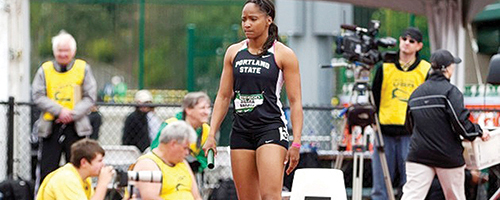“Jumptown.” You may have heard it before among a long list of Portland’s nicknames. And like the other titles bestowed upon this city, it is rooted uniquely in Portland’s history—in the days when jazz filled the eastside streets as much as the Oregon rain.
Portland’s Jumptown
“Jumptown.” You may have heard it before among a long list of Portland’s nicknames. And like the other titles bestowed upon this city, it is rooted uniquely in Portland’s history—in the days when jazz filled the eastside streets as much as the Oregon rain.
On the inner eastside, where we now pass through on the MAX, watch the Blazers play, or catch a Winterhawks game, there was once a vibrant area rich with nightlife and jazz music. Artists such as the Nat King Cole Trio and Thelonious Monk filled venues with their unique talents as they passed through town. Other acts such as tap dancers, strippers and comedians performed to crowded venues. It was the liveliest part of town. This was Jumptown—not just a place, but a moment in Portland’s history where jazz reigned.
Back in the day
In his book Jumptown: The Golden Years of Portland Jazz, Robert Dietsche reveals that Portland’s jazz scene emerged after a mass migration of African-American workers to the city in the 1930s—workers who would build the Bonneville Dam. The dam provided easy and cheap energy that various industries were drawn to, many of which settled on the banks of Portland’s Willamette River. By the time World War II was in full swing, Portland’s shipyards and rail lines were heavy with a manufacturing industry needing workers to keep the war effort on track.
During World War II, much of Portland’s African-American population worked in the shipyards and on the railroad located on the east banks of the Willamette River. They in turn settled not far from this area, partly because of the proximity to the eastside industrial region, but also because of Portland’s ill-famed “red line” that systematically and economically separated African-Americans and Asians from established white neighborhoods.
From this inner-eastside community would surface a jazz scene uniquely Portland. Clubs and other venues sprung up and down Williams avenue. It was the hot spot in Portland, unrivaled by any other social scene in the city, even by today’s standards. It was 24 hours of jazz and entertainment pulsing through the lively streets of east Portland, now covered by the Rose Quarter.
Venues such as the Dude Ranch, Lil’ Sandy’s, Slaughter, the Savoy and more were home to an abundance of musicians, one of which was Monte Ballou and the Castle Jazz Band which would rise to be one of the most popular bands to come out of Portland. Being an all-white band, their range of venues was able to span across the river into downtown.
“Stop anyone on the corner of Southwest Broadway and Salmon in the ‘40s and ‘50s. Ask them who it is that best personifies jazz in Portland,” Dietsche wrote in Jumptown, “And nine out of 10 would tell you Monte Ballou and his Castle Jazz Band.”
While the African-American community brought jazz to the area, Jumptown was a world unto itself where people of all types came to cut loose.
“Racially mixed party people who couldn’t care less that what they were doing was on the cutting edge of integration in the city that had been called the most segregated north of the Mason-Dixon line,” Dietsche wrote.
Portland is still jazzy
In the decades to come, Jumptown would fall to the might of progress. Eventually the Rose Quarter came to stand on top of what was one of the liveliest areas on the west coast. But Portland has not forgotten the music it loved so well. The city even has its own jazz festival held each year in February. The festival’s mission is to further jazz as “America’s most recognized indigenous art form.”
Today, the music can be found in a variety of bars and clubs across the city, all well-stocked with musicians holding a fervor for the art.
The Tugboat Brewing Co. is one such place. Almost hidden on a small bend of Southwest Ankeny Street, Portlanders can enjoy more than just the unique ales the pub offers. Jazz is played most nights here, and not just any jazz. Artists play for their passion for the craft at the Tugboat.
“Generally what we play is original music and we tend to have more avant-jazz,” said Tugboat bartender Linsel Greene. “We have local artists playing original music…for tips; nobody is getting rich at the Tugboat.”
Across town off of Southeast Belmont is the Blue Monk. Looking over the walls of the Blue Monk is to take a peek into Portland’s jazz history with photos and other mementos from the past. Aside from providing a nice dining atmosphere, the Blue Monk also hosts live jazz acts most evenings.
It’s hard to think about jazz in modern Portland without Jimmy Mak’s off of Northwest 10th Ave. Certainly one of Portland’s most chic and hip locals, Jimmy Mak’s hosts a number of top jazz talent set in an ambience of fine dining. There are not too many other places in Portland where you can enjoy a filet mignon and wine against a brilliant jazz quartet.
Despite Jumptown being paved over, the jazz that it thrived upon still lives in the city of roses. Though the music scene today may be geared more towards hipsters and indie bands, jazz remains scattered across the city. It can be found in a variety of clubs for either those seeking a laid back joint, or for those ready to jump.



